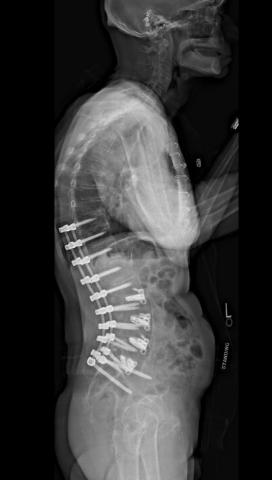Table of ContentsClose

Daimon Cundiff’s back pain was so severe that he felt his life dwindling. This was 2021, when daily walks with his wife, Dixie, turned painful. The 71-year-old great-grandfather of five found himself squatting every 100 yards to take pressure off his throbbing hip. Numbness in his legs prevented him from going on long bike rides, too.
For the active retiree in Geneseo, Illinois, these mounting problems—stemming from a progressive narrowing of his spinal canal called spinal stenosis—were the last straw.
“Everything I enjoyed in life was becoming way less enjoyable, or I couldn’t do it at all,” he says.
What wasn’t difficult was Cundiff’s decision to travel 87 miles to University of Iowa Health Care, where he underwent major, two-stage surgery in April 2023. UI spine surgeons fused an extensive swath of vertebrae in his lower back, stabilizing the spine and decompressing nerves that were causing his distressing symptoms. Cundiff had already relied on UI Health Care expertise for two prior cancer surgeries, and a spine specialist closer to home steered him there once again, saying, “What you need done, I am not qualified to do.”

physical activities. Photo by Liz Martin.
More older adults needing spine surgery
Cundiff’s case exemplifies a growing trend at UI Health Care, where adults ages 65 and older comprise the majority of patients seeking cutting-edge spine surgery—which is often elective—for much-needed relief.
Back pain is one of the most reported medical problems in the United States, according to a 2021 Centers for Disease Control and Prevention report indicating that nearly four in 10 adults dealt with the issue. But for adults age 65 and up, this proportion grew to nearly 46%—and will likely continue to increase as the United States’ population ages. By 2034, older adults will outnumber children under 18 for the first time in U.S. history, according to the U.S. Census Bureau.
“We do have younger patients, but we’re seeing more and more older adults requiring surgical intervention,” says UI Health Care spine surgeon Catherine Olinger, MD, a clinical assistant professor in the Department of Orthopedics and Rehabilitation. “People are living longer and requiring spine surgery more than even 20 years ago.”
With deep surgical expertise and advanced capabilities, UI Health Care is uniquely poised in both the state and region.
“We can take care of anyone who walks in the door because of our setup and surgical capabilities,” Olinger says. “We’re accustomed to handling the most difficult problems, and patients understand that.”
Caring for spine problems and comorbidities
Back pain experts at Iowa—which include specialists in spine surgery, neurosurgery, physical therapy, sports medicine, and physical medicine and rehabilitation, among others—tackle the gamut of conditions affecting the spine in patients of all ages. This includes everything from muscle strains, spasms, and herniated discs to a range of degenerative spine disorders, scoliosis, spinal trauma, tumors, and infections.
But older adults who arrive at UI Health Care often have long-standing back problems that further deteriorate as they age. Like Cundiff, many have been referred from other hospitals that aren’t equipped to deal with the scope and severity of a patient’s condition. UI Health Care is the only institution in the state able to handle surgeries to correct spine deformities in adults, and it has the only surgeons in Iowa who can perform degenerative scoliosis correction surgery.
“A lot of patients come here because we have the resources and surgical expertise to take care of those cases,” says spine surgeon Cassim Igram (88MD), a clinical professor in the Department of Orthopedics and Rehabilitation. “The combination of medical resources and surgical expertise at UI is unmatched here in Iowa.”
Older patients’ diagnoses often fall into two camps: spinal stenosis and spinal arthritis. Many spine surgeries done on older patients at UI Health Care involve spinal fusion, whether on a small part of the spine or a wide swath, like Cundiff’s.
But even more run-of-the-mill spine problems—such as disc herniation or spondylolisthesis, when one vertebra slips out of place onto the bone below it—may require expertise from a range of UI Health Care specialists when patients also have chronic conditions such as diabetes, neuropathy, or osteoporosis. These and other comorbidities are more common in aging adults.
“Each process or problem compounds one another,” Olinger says.

Resource and referral center
Most patients assessed for back problems, however, don’t need an operation, and conservative treatments are nearly always tapped first.
“I tell patients that 80% of people will have a back- or leg-related problem in their lifetime, and 80% of them will get better with physical therapy, epidural spine injections, exercise, weight loss, or measures like diabetes or blood pressure control,” Olinger says.
But a higher proportion of older adults seen at UI Health Care for back problems go on to have surgery because many referrals are fielded from institutions not equipped to manage increasingly complex cases.
“More often than not, patients come to us as a second or third opinion,” Olinger says. “They may have undergone multiple injections and even years of physical therapy and are basically at the brink, where nothing else but surgery will help.”
Age isn’t always a deciding factor for which older adults should undergo spine surgery. Goal-setting is also integral to the process, according to Olinger.
“I’m there for them and to treat them whether or not they need surgery,” she says. “All of us are very hands-on and spend a great deal of time with our patients. We have a tailored, personalized program for every patient who comes here.”

Collaboration, innovation in getting the back together again
By performing minimally invasive and innovative techniques whenever possible, UI spine surgery patients experience fewer complications than average and report higher-than-average satisfaction with their surgeries. Olinger says they often describe immediate improvement in the symptoms that led them to undergo spine surgery in the first place.
Some of these surgical outcomes can be linked to approaches offered at UI, including anterior, lateral, and posterior-based approaches. Surgical approaches tailored to the patient’s needs—which in some cases can reduce trauma to muscles and surrounding soft tissues—can improve recovery. UI spine surgeons also offer staged procedures over several days that are less taxing for patients than undergoing one long surgery.
Collaboration is key. UI spine surgeons work with a broad, interdisciplinary team to manage all aspects of care, including clinical pain psychologists, pharmacists, physical therapists, and others. Cardiac and vascular surgeons assist operations on patients with certain comorbidities, and the intensive care unit is sometimes involved, too. Other departments are also tapped to optimize patients for surgery beforehand, including efforts to strengthen the bones of patients with low bone mass.
“Orthopedics and neurosurgery work very closely together,” Igram says. “We’re Iowa’s only tertiary care referral center. For many patients across Iowa, we’re the last stop.”
Cundiff can readily attest to the success of this philosophy. Within six weeks of his surgery, he was back to walking several miles a day—much sooner than Olinger had predicted. And while he recalls how grueling his initial recovery was, Cundiff is unflinching in his belief that the ordeal was worth it.
“After I was cleared by the doctor, my wife and I rode well over 500 miles on our bicycles between June and September and walked two to four miles a day,” he says. “The only thing that hinders us now is the weather.”
Innovative research aims to control pain, prevent delirium
When older adults undergo spinal fusion surgery, pain isn’t the only postoperative challenge. Delirium—which is marked by confusion and a disturbing change in mental abilities—can derail long-term outcomes, and it occurs in more than 40% of the 100,000 older adults who undergo spinal fusion in the United States each year. A pilot study spearheaded by UI Health Care spine surgeon Catherine Olinger, MD, seeks to curb these complications.
Olinger is studying regional nerve blocks to improve recovery in older adults who undergo spinal fusion surgery, which permanently joins two or more bones in the spine to reshape or stabilize it. She’ll learn if using a regional nerve block, called a thoracolumbar interfascial plane (TLIP) block, instead of opioids—which can pose complications of their own—better hinders pain that can contribute to delirium.
“One of the main risk factors for delirium is pain,” she says. “If this intervention reduces the overall rates of pain, then in theory, it will reduce rates of delirium as well.”

Center of excellence
Expertise in knee and hip replacement and spine surgery has earned UI Health Care the Wellmark Blue Cross Blue Distinction® Center+ designation, signaling that Iowa is a center of excellence that delivers high-quality, specialized care and better results.
